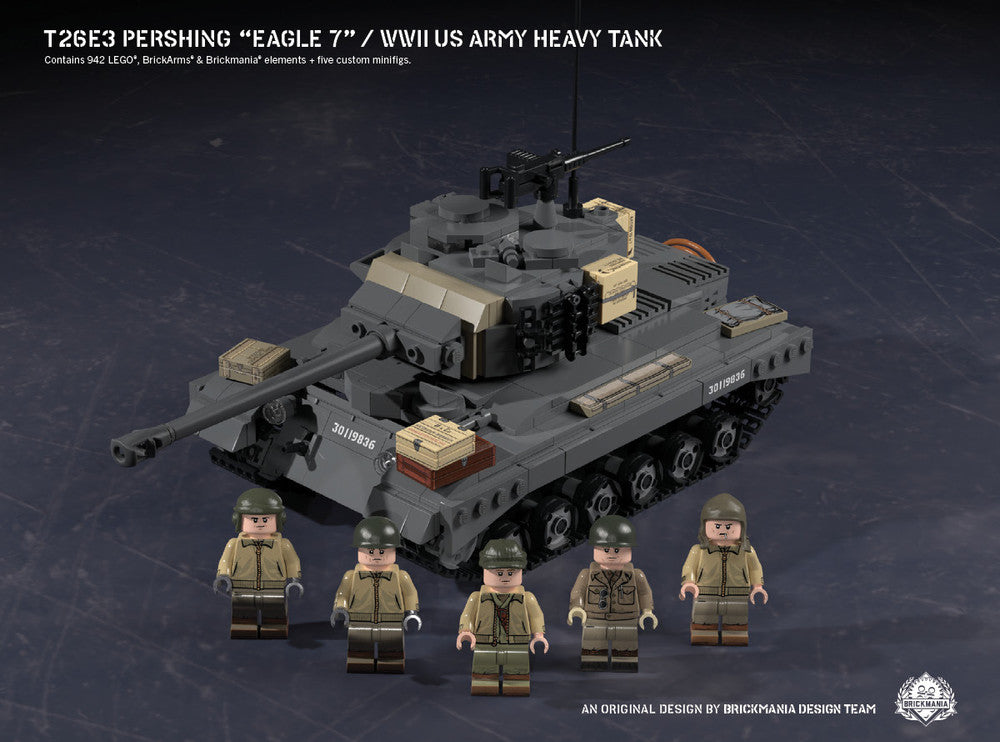This store requires javascript to be enabled for some features to work correctly.
※Due to customs regulations, postal shipments to the United States are temporarily suspended. (DHL services are still available.)
About the T26E3 Pershing "Eagle 7" – WWII US Army Heavy Tank:
The American M26 Pershing tank was the Allied answer to Germany’s mighty Panther and Tiger tanks. However, the Pershing’s history, from prototype to field testing, is muddled in mystery. The United States began testing the idea of a heavy tank for tank vs. tank conflict as early as 1936. Yet, as the world erupted into war, the United States and its military branches focused on the idea of a mass-produced medium tank that fulfilled a multitude of roles. The M4 Sherman was an icon of the war and its iterations that succeeded all attempted to add onto the base design to create a more powerful weapon. However, the law of diminishing return eventually limited the capability of the Sherman. As German Panzers grew more powerful, the realization of a better, more powerful tank took shape. The Sherman needed to be supplanted by an all-new design. Originally, Tank Destroyers were used to fend off the mightier enemy. These included the M10 Wolverine and M36 Jackson, but eventually, the lines of tank and tank destroyer blurred. Strategically, they didn’t prove as effective in combat as thought on paper. A tank that could meet both roles was needed. The heavy tank program was finally given the light it needed, even if it entered the war too late.
Prototyping of the M26 started shortly after the Allied invasion of Normandy. Two prototypes were produced simultaneously, the T25 and T26. The T25 used a large cast turret to house a 90mm gun while the T26 increased the frontal glacis armor to 102mm and reinforced the hull. For suspension, the T25 used a VVSS suspension as seen on previous iterations of the Sherman. The T26, on the other hand, used a torsion bar-based suspension, like that on the Chaffee. The final prototype tank—T26E3–combined the gun of the T25 with the suspension and armor of the T26. This gave birth to the M26 Pershing. The result created a tank that was more powerful than any American tank to that point. It was a revolution in tank design. The tank boasted a prodigious 90mm gun with the thickest glacis armor of any American tank. For features, the gunner was given an M10 periscope with 6X magnification for precise shots. To make aiming even easier, the turret was given a power traverse function, which the gunner controlled via joystick. Of course, power functions could fail in the heat of battle so manual traverse and firing were added in case of electrical failure. The tank was powered by a new Wright engine specifically designed to handle the tank’s 46-ton weight class. Other features included a commander’s periscope, co-axial Browning machine guns, sprung suspension seats for the driver and assistant diver, and an SCR 5-28 radio set. Due to delays caused by bureaucratic complacency and a lack of urgency, only 20 M26 Pershing tanks saw combat in Europe before the fall of the Third Reich. However, one Pershing—known as Eagle 7– made history.
A Pershing, serial number 26, entered the foray of combat on February 22, 1945, with Easy Company of the 3rd Armored Division; known to the troops as “Spearhead.” Painted in white on the Pershing was its identifier designation, E7. Clarence Smoyer, the tank’s gunner, and crew quickly christened the tank Eagle 7. Clarence’s detailed account of the Battle of Cologne in 1945 depicts an epic tank v. tank battle between his M26 and a German Panther—the tank that sparked the development and production of the Pershing. In Spearhead: An American Tank Gunner, His Enemy, and a Collision of Lives in World War II, historian Adam Makos unearths and discovers the story of Clarence. It is a story that epitomizes the “Greatest Generation” and their fight to overcome Hitler. However, as unveiled by Makos, the story is also about survival, for both sides. Victory was near for the Allies, both sides understood that. Germany was attempting to delay the inevitable, while her soldiers were just trying to stay alive to return home. In a heart-quenching sequence, the 3rd armored came across a farmer as they entered Germany. There, the tankers of Easy Company learned the reality of war. “Clarence had always thought of the Germans they killed in battle as faceless soldiers without an identity,” stated Makos. “Not as sons, with fathers or mothers who worried about their safety. It wasn’t until now that he saw an awful truth in the old man’s eyes. War touches everyone.”
Join our Mailing List
Thanks for Joining!

